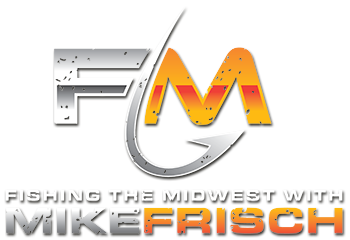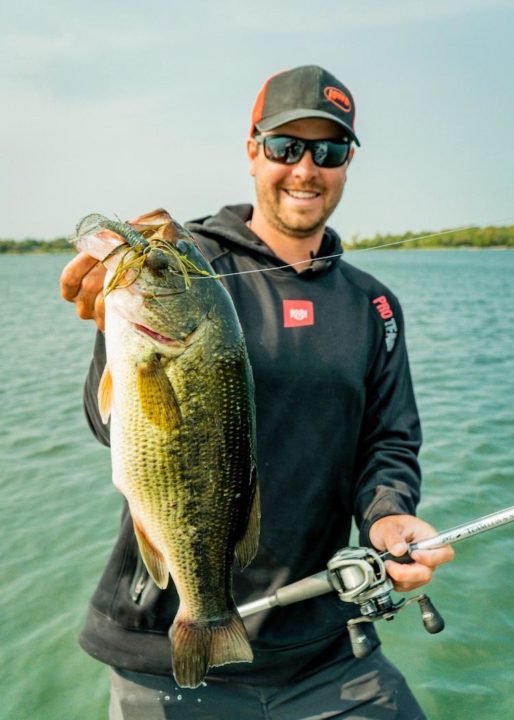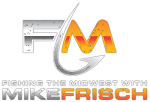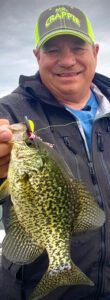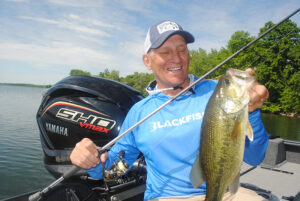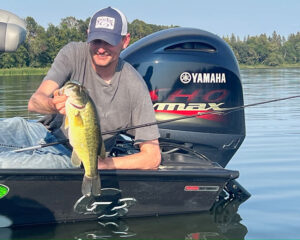GO BIG FOR BIG BASS
by Bob Jensen
Autumn has arrived in the Midwest. In a couple of weeks in some places, right now in other places, the lakeshores and roadsides will be alive with color. Lots of outdoor enthusiasts will have departed the lakes for tree stands in search of deer or fields looking for pheasants, ducks, or geese. I like that. Outdoor activities are good, and the fall is maybe the best time of the year for outdoor activities. I hung my shotgun up a few years ago and now focus on catching fish. There’s a reason for that. The big ones are hungry. Now is when your chance for a trophy is best, and big baits are what it takes to catch big fish.
I got a phone call from my friend Mike Frisch last night. He had been on the water all day with Cole Floyd. Cole is a professional bass fisherman from Ohio. He was in Minnesota fishing a tournament, and when the tournament was over, Cole did what many anglers do: He hung around and fished some more. He was very impressed with the bass fishing in Minnesota and wanted more of it before he started the long drive back to Ohio. Here’s how Cole and Mike got in on some outstanding bass action for larger than average Midwest largemouth bass in the fall.
The days are getting shorter and the water temperatures are going down. This signals to the fish that it’s time to put some fat on. Mother Nature is ringing the dinner bell and the fish are responding. Our two anglers know that when larger than average fish are the target in the fall, larger than average baits will usually produce better. Largemouth, smallmouth, walleye, northern pike, muskies, even panfish: If you’re after the big ones, go with bigger baits.
Also, the baitfish that were spawned in the spring are at a larger size now, and some baitfish that are fall spawners are more accessible to the predator fish now. It seems that the larger predator fish are more interested in eating the size baitfish that are more abundant now.
Mike knows the lakes around his home area very well, and he knows that in the fall, the weedline is a good place to start. On many days that’s also where they’ll end. If the day is overcast, or if there’s a little wind, the bass will be shallower. They’re also often shallower early and late in the day.
The guys were on the water mostly from mid-morning until later in the afternoon. They spent a good amount of time on the deep weedline. They looked for turns or points in the weedline, and they also looked for heavier clumps of weeds. Those are the spots that concentrated the fish.
They started the day with Hack Attack Flipping Jigs tipped with bulky Rage Bugs. This is where things got interesting and a bit out of the ordinary for Mike. Cole suggested going with a three-quarter ounce jig although to Mike, the water depth suggested the half ounce size would be more appropriate. Cole indicated that the larger jig would enable them to fish faster, and because the heavier jig fell faster, there would be more reaction strikes from the bass. They had very good success with the heavier jig.
After working down the weedline with the jigs, our duo picked up their Texas-rigged rods and went back over the same area. They had Rage Cut-R Worms in the 7 inch length attached. This is a more subtle presentation than the jig. The fish that didn’t want the jig were more likely to hit this rig. Again, they went with heavier weights, and again, they had very good success. They caught several larger than average bass. Whether we’re talking jig/plastic or just plastic, Watermelon or Green Pumpkin are good colors to start with almost anywhere that bass live.
Autumn is a great time to be on the water. If you want to catch a larger than ordinary bass, you’ll increase your chances of doing so if you use a larger than ordinary bait.
PHOTO CAPTION-Cole Floyd with an autumn largemouth taken on a big jig tipped with a bulky plastic!
